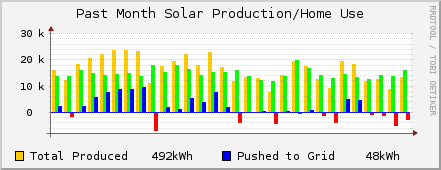TLDR version: adding solar panels can drastically reduce the required battery bank size for off-grid solar.
Adding just two more panels to my 15 panel array could reduce the size battery bank I would need to get me through current monsoon weather from 60kwh to 20kwh.
Long version:
My power coop has proposed a new pricing schedule for solar customers that they are planning on phasing in over the next 4-5 years. If this goes through it will be cheaper for me to buy batteries and go off-grid than it will be to stay grid-tied.
With this in mind I have been collecting production and consumption data since the beginning of May. I've been collecting data for years, but previously I wasn't concerned with whether the power I consumed came directly from my solar production or from the grid. Up until now my power coop allowed me to 'bank' my surplus energy for later use at a 1:1 ratio.
Anyway back in may I started tracking where my power was coming from on a continuous basis. If I go off grid, anything that I would have pulled form the grid would have to come from batteries and I'll need to know how large of a battery bank I'll need.
One way to estimate battery bank size is to take your average daily consumption and size the bank large enough to handle several days without any solar input. So if you live somewhere that frequently experiences storms that last 2-3 days then maybe you make sure your bank can power your house for 4 days.
However, since I have hard data available and several years for planning I'm taking the data and feeding it into a spreadsheet. The spreadsheet takes the energy I'm currently sending out to the grid and adjusts it for estimated charging losses, battery capacity, etc. With this I can see what size battery bank I'll need taking into account actual usage and production based on current weather patterns.
My solar production/energy consumption for the last month:
Table showing production, consumption and percentage supplied by the grid
A couple points worth noting:
While it is convenient to assume a worst case of zero input from the solar array, this doesn't actually happen (short of hardware failure). In the 7 years my array has been online the lowest production I've ever seen was still approx 10% of maximum production.
Energy use during stormy weather is often lower than during clear days, at least it is where I live. Most of our cloudy weather happens during the summer and cooling requirements go way down on cloudy days. Interestingly, during the winter cloudy days tend to be warmer than clear days/nights. The clouds act like a blanket to trap heat, whereas clear nights and low humidity can result if very cold nights as the heat radiates away.
Lead-Acid batteries last longer if they are kept mostly charged most of the time. A smaller bank with a larger array will tend to run at a higher State of Charge(SOC) than a larger bank with a smaller array. In my case a 20kwh battery with a 4kw array would only have been below 50% SOC on three days during the past month and never goes below 20% soc. A 40kwh battery with a 3.5kwh array would have spent 8 days below 50% SOC and 1 day below 20% and one day completely discharged leaving me 3kwh short on energy.
Panels are cheaper than batteries. 2 panels are a LOT cheaper than 20kwh worth of batteries, plus the panels will last over 30 years, the batteries maybe 6-8 years.





























